You are using an out of date browser. It may not display this or other websites correctly.
You should upgrade or use an alternative browser.
You should upgrade or use an alternative browser.
Exciting day - rebuild of 78 coupe
- Thread starter johng
- Start date
Chuffer
CCCUK Member
When I rebuilt my headlight vacuum system and vac lines it didn`t half improve the way the engine ran . Even the slightest vac leak has a significant effect .Wonder if the engine will run differently now??
johng
CCCUK Member
Having tried alternative repair strategies with my original relays, I decided to take off the new ones today to see what exactly was the problem with them. As it turned out both of them were only leaking from one end and luckily enough it was the end that you can at least partly get to. Since the hardest part of the repair was removing (and replacing) the crimp ring around the actuator, I thought I'd have a go at repairing them without taking them apart. I've managed to fit a small o ring inside the seal at the end of the piston, which pushes out the seal and for now at least stopped them leaking. You can just see this in this photo of one of my old relays (I forgot to take any photos of the new ones before I put them back in the car!).
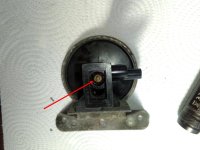
So at the moment I have working lights, working Max AC and 20in Hg vacuum at idle. On the other hand my interior light delay timer has now packed up, so another job to do.

So at the moment I have working lights, working Max AC and 20in Hg vacuum at idle. On the other hand my interior light delay timer has now packed up, so another job to do.
johng
CCCUK Member
So another problem has arisen. Before Christmas my eagle eyed area rep noticed a small wet patch under the front of my car. This turned out to be a small leak from my radiator. I had noticed this a few years ago shortly after I rebuilt the car and tried putting some leak sealant into the rad, which worked for a few years, but I decided this time I ought to replace the rad. Santa kindly bought me an aluminium 3 row replacement and I've just got around to fitting it. From what I'd read this was going to be a tricky job, The bonnet, fan, waterpump pulley, belts and shroud would all need to come off and it would take 2 people to remove the rad without damaging the paintwork. In reality I needed to remove the fan and loosen the shroud. What was a bit tricky was disconnecting the foam seals that I had stuck in place down both sides of the rad. After that it was easy enough to lift out the rad on my own.
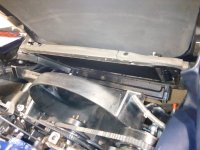
Now I need to flush everything through and fit the new rad. It looks like I might need to replace one of my auto trans cooler hoses, does anyone know what spec hose I'll need for this?

Now I need to flush everything through and fit the new rad. It looks like I might need to replace one of my auto trans cooler hoses, does anyone know what spec hose I'll need for this?
johng
CCCUK Member
Things didn't go quite as simply as I'd hoped (as per usual). I found quite a lot of rust particles in my hoses although I had flushed the system through before putting the engine back in the car. What I realised I hadn't done previously was to remove the drain plugs in the block whist I had the engine out, big big mistake! These are real pigs to get with the engine in the car. The spark plug lead covers completely cover them and the exhaust and starter motor are in the way as well. Eventually got them out and flushed the block. The heater core was easy to flush but had nothing but clean water in it anyway. In taking off the lower hose I managed to snag the spring inside it and snap it. It was the original one that I had re-used when putting new hoses on, so was well corroded and pretty thin anyway. I can't find a ready replacement so I'm planning to make one from some galvanised wire. I'm not entirely sure it is even needed as I've seen a suggestion that they were only fitted to avoid hose collapse during vacuum filling of the system on the production line, but better safe than sorry. I definitely need to replace the auto trans cooler hoses because the fittings that came with the radiator are shorter than the originals, so I will need longer hoses. I think the type I need is SAE J30 R9, which is fuel injection hose.
Forrest Gump
CCCUK regional rep
What make of radiator have you gone for John?
No spring in my lower hose btw.
No spring in my lower hose btw.
johng
CCCUK Member
It's a cheap Ebay special Andy, less than £200 delivered. Since my low powered engine never overheated on the old somewhat crusty radiator I'm hoping it will be fine with this. The welding on it looks fine. I have got silicone hoses which do feel quite soft, so I will have a go at making a spring
johng
CCCUK Member
Well that took a lot longer than expected. I ordered a new thermostat, housing and gasket from Rock Auto which arrived in 3 days, but the new hose for my transmission cooler took nearly 2 weeks to get here from Derbyshire. I made a spring for the bottom hose by winding some 2mm galvanised wire around an old curtain pole.
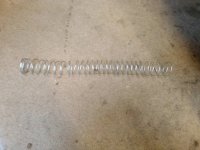
Then the fun started! The ebay radiator is slightly wider then the original, but this was easily fixed by trimming some rubber off the mount insulators. The more serious problem was the transmission cooler connection. Both the fittings on the new radiator are straight (as shown in this photo), whereas the original upper fitting was a 90 degree bend.
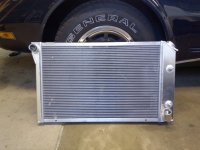
When I put the radiator into position, the upper fitting was almost touching the upper control arm with no chance of getting the hose onto it. Simple I thought, I'll just use the old 90 degree fitting, but the threads are not the same on the 2 rads!. The old fitting would fit into the new rad, but was a bit of a loose fit and the new fitting won't fit into the old rad at all. I didn't want to chance the old fitting, I didn't know where I could get a 90 degree fitting with the correct thread and I was getting a bit impatient by this time, so decided that the best solution would be to move the radiator forward to create more space for the hose. This meant turning the rubber mounts round 180 degrees and cutting down the thickness of the seals between the radiator and the support frame. This moved the radiator forward by about 20mm, but then meant I had a 20mm gap between the radiator and the shroud which I then had to make up some seals for.
You can just see here how I've routed the transmission cooler hose to avoid it touching the control arm (just).
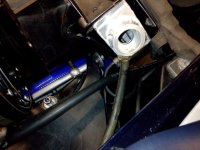
It's now all sealed up, filled with fresh coolant and all seems good ticking over in my garage. Just need to take it for a run to make sure there are no leaks or other issues.

Then the fun started! The ebay radiator is slightly wider then the original, but this was easily fixed by trimming some rubber off the mount insulators. The more serious problem was the transmission cooler connection. Both the fittings on the new radiator are straight (as shown in this photo), whereas the original upper fitting was a 90 degree bend.

When I put the radiator into position, the upper fitting was almost touching the upper control arm with no chance of getting the hose onto it. Simple I thought, I'll just use the old 90 degree fitting, but the threads are not the same on the 2 rads!. The old fitting would fit into the new rad, but was a bit of a loose fit and the new fitting won't fit into the old rad at all. I didn't want to chance the old fitting, I didn't know where I could get a 90 degree fitting with the correct thread and I was getting a bit impatient by this time, so decided that the best solution would be to move the radiator forward to create more space for the hose. This meant turning the rubber mounts round 180 degrees and cutting down the thickness of the seals between the radiator and the support frame. This moved the radiator forward by about 20mm, but then meant I had a 20mm gap between the radiator and the shroud which I then had to make up some seals for.
You can just see here how I've routed the transmission cooler hose to avoid it touching the control arm (just).

It's now all sealed up, filled with fresh coolant and all seems good ticking over in my garage. Just need to take it for a run to make sure there are no leaks or other issues.
johng
CCCUK Member
Took the car out this afternoon and all seems well, although I'm now sure that my water temp gauge reads low. It used to say the car was running at around 170F (that was with a 195F thermostat). I've now put in a 180F thermostat and the gauge reads 150F. With both thermostats, the themostat was/is certainly opening so the water must be hotter than the gauge claims.
teamzr1
Supporting vendor
Where is the coolant temp sensor located ?
Using the infrared temp tool, what is the temp of the block near the coolant temp sensor ?
Does this radiator flow higher volume than stock would ?
What controls the cooling fan ? (is fan running and on all the time ?)
If heater is ON, how hot does the air feel, use an infrared temp tool and measure ?
Does the radiator also cool tranny ?
What is the weather temp ?
Use an Ohm meter from engine block as ground to the tip of the coolant temp sensor tip where wire connects to and
read the resistance and then match to this table to see if it is wrong or the temp gauge in dash
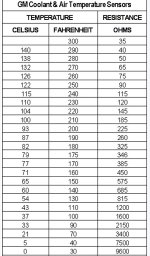
Using the infrared temp tool, what is the temp of the block near the coolant temp sensor ?
Does this radiator flow higher volume than stock would ?
What controls the cooling fan ? (is fan running and on all the time ?)
If heater is ON, how hot does the air feel, use an infrared temp tool and measure ?
Does the radiator also cool tranny ?
What is the weather temp ?
Use an Ohm meter from engine block as ground to the tip of the coolant temp sensor tip where wire connects to and
read the resistance and then match to this table to see if it is wrong or the temp gauge in dash

Last edited:
Chuffer
CCCUK Member
If the weather was below freezing like around my way most of the time I am not surprised your gauge read a bit low . How many miles did you drive ?Took the car out this afternoon and all seems well, although I'm now sure that my water temp gauge reads low. It used to say the car was running at around 170F (that was with a 195F thermostat). I've now put in a 180F thermostat and the gauge reads 150F. With both thermostats, the themostat was/is certainly opening so the water must be hotter than the gauge claims.
johng
CCCUK Member
Actually weather was pretty good here this afternoon (for the time of year!) around 7C. I went about 10 miles and temperature was stable. Thing is it previously only read 170F even on very hot days and now I've discovered it had a 195F thermostat in it, I'd always imagined it was a 180F.
Chuffer
CCCUK Member
Pure speculation here , but your new rad will prabably be more effective at cooling than the old one and a 10 mile drive will only just be getting the car up to full operating temp . Add to that an ambient air temp of 7 C + wind chill at what ever speed you were driving and I would think 150 degrees on the gauge is nothing to get stressed about for this time of year .Actually weather was pretty good here this afternoon (for the time of year!) around 7C. I went about 10 miles and temperature was stable. Thing is it previously only read 170F even on very hot days and now I've discovered it had a 195F thermostat in it, I'd always imagined it was a 180F.
johng
CCCUK Member
Thanks for this, I'll check out the sensor at the weekend and take some measurements with an IR gun.Where is the coolant temp sensor located ?
Using the infrared temp tool, what is the temp of the block near the coolant temp sensor ?
Does this radiator flow higher volume than stock would ?
What controls the cooling fan ? (is fan running and on all the time ?)
If heater is ON, how hot does the air feel, use an infrared temp tool and measure ?
Does the radiator also cool tranny ?
What is the weather temp ?
Use an Ohm meter from engine block as ground to the tip of the coolant temp sensor tip where wire connects to and
read the resistance and then match to this table to see if it is wrong or the temp gauge in dash
The new rad probably does flow more than the original, it's still got the original type clutch fan. Heater gets lovely and hot and radiator does also cool the transmission.
Weather was a nice sunny 7C today.
teamzr1
Supporting vendor
Thanks for this, I'll check out the sensor at the weekend and take some measurements with an IR gun.
The new rad probably does flow more than the original, it's still got the original type clutch fan. Heater gets lovely and hot and radiator does also cool the transmission.
Weather was a nice sunny 7C today.
7C is only about 44 F deg and with a new radiator and hoses would have a good fast flow and in ten-mile drive I doubt it would get to
180 F deg, with hot air from heater says coolant pumps working and no air pockets in coolant
Just to test coolant sensor and dash gauge, be worth doing the IR tests and Ohm test just so you know gauge is reporting accurate tmp values
Do you use 50/50% of water/antifreeze ?
Roscobbc
Moderator
John - if its anything to go by mine with its ally radiator in temperature like todays and on a steady run would only reach about 150. It would only be in bumper to bumper town traffic that it woud even stand a chance of reaching 170/175..........if ambient temperatures were 20 or more a totally different situation.
johng
CCCUK Member
That's interesting Ross. I'd never really thought much about it, but just imagined the thermostat would open and close to maintain a set temperature (at the thermostat rating). I'm guessing now that the closing temp of the thermostat is quite a bit lower than the opening temp, hence allowing the engine to run cooler than the thermostat rating.
Roscobbc
Moderator
I had a fair bit of difficulty 'balancing' the need for a thermostat of a specific temperature that would A. remain closed untill the engine warmed-up properly........and B. that would remain open enough without affecting flow rate to prevent running too hot.
A cool summer evenings run back from a club night would see temperatures as low as 150 - 160 degrees..........yet the run to the meeting earlier in the evening when maybe it was far warmer, perhaps rather humid would see temperatures of 185 -190 or more.
Some people drill the opening plate of the thermstat to allow a better flow of coolant when closed (and also when open). I found an old Nissan thermostat in my garage that unusually had a threaded opening plate allowing adjustment of closing position and water flow rate through the 'stat. This seemed to improve matters.
A cool summer evenings run back from a club night would see temperatures as low as 150 - 160 degrees..........yet the run to the meeting earlier in the evening when maybe it was far warmer, perhaps rather humid would see temperatures of 185 -190 or more.
Some people drill the opening plate of the thermstat to allow a better flow of coolant when closed (and also when open). I found an old Nissan thermostat in my garage that unusually had a threaded opening plate allowing adjustment of closing position and water flow rate through the 'stat. This seemed to improve matters.
johng
CCCUK Member
No such problems with mine Ross, no doubt due to vastly different power outputs of our engines! Mine warms up fairly quickly and then sits at a constant temp no matter what I'm doing or the ambient temp. I did once get it up to 190F sitting in traffic with the aircon on on a scorching hot day.
